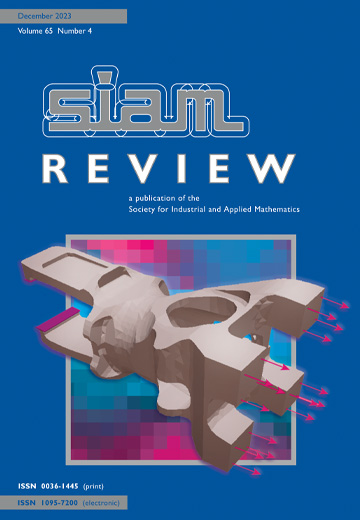二阶自交点微分算子广义谱的简单公式
IF 6.1
1区 数学
Q1 MATHEMATICS, APPLIED
引用次数: 0
摘要
SIAM Review》第 66 卷第 1 期第 125-146 页,2024 年 2 月。 我们分析了受同质 Dirichlet 或 Neumann 边界条件约束的算子 $\Delta^{-1} [\nabla \cdot (K\nabla u)]$ 的谱,其中 $\Delta$ 表示拉普拉斯函数,$K=K(x,y)$ 是对称张量。我们的主要结果表明,这一频谱可以从频谱分解 $K=Q \Lambda Q^T$ 得出,其中 $Q=Q(x,y)$ 是正交矩阵,$\Lambda=\Lambda(x,y)$ 是对角矩阵。更确切地说,只要 $K$ 是连续的,频谱就等于 $\Lambda$ 对角函数项范围的凸壳。所涉及的域假定是有界的和 Lipschitz 的。除了研究定义在无穷维索博列夫空间上的算子外,我们还报告了有关其离散化有限维对应算子的最新结果。更具体地说,尽管$\Delta^{-1} [\nabla \cdot (K\nabla u)]$ 并不紧凑,但事实证明,这个算子谱中的每一点都可以用离散化产生的相关广义代数特征值问题的特征值来近似,精确度可以达到任意程度。我们的理论研究得到了数值实验的启发。本文提出的结果扩展了之前针对具有标量系数函数的椭圆微分算子的分析。我们进行研究的动机既包括预处理问题(高效数值计算),也包括进一步发展二阶 PDE 的谱理论(核心分析)。本文章由计算机程序翻译,如有差异,请以英文原文为准。
A Simple Formula for the Generalized Spectrum of Second Order Self-Adjoint Differential Operators
SIAM Review, Volume 66, Issue 1, Page 125-146, February 2024.
We analyze the spectrum of the operator $\Delta^{-1} [\nabla \cdot (K\nabla u)]$ subject to homogeneous Dirichlet or Neumann boundary conditions, where $\Delta$ denotes the Laplacian and $K=K(x,y)$ is a symmetric tensor. Our main result shows that this spectrum can be derived from the spectral decomposition $K=Q \Lambda Q^T$, where $Q=Q(x,y)$ is an orthogonal matrix and $\Lambda=\Lambda(x,y)$ is a diagonal matrix. More precisely, provided that $K$ is continuous, the spectrum equals the convex hull of the ranges of the diagonal function entries of $\Lambda$. The domain involved is assumed to be bounded and Lipschitz. In addition to studying operators defined on infinite-dimensional Sobolev spaces, we also report on recent results concerning their discretized finite-dimensional counterparts. More specifically, even though $\Delta^{-1} [\nabla \cdot (K\nabla u)]$ is not compact, it turns out that every point in the spectrum of this operator can, to an arbitrary accuracy, be approximated by eigenvalues of the associated generalized algebraic eigenvalue problems arising from discretizations. Our theoretical investigations are illuminated by numerical experiments. The results presented in this paper extend previous analyses which have addressed elliptic differential operators with scalar coefficient functions. Our investigation is motivated by both preconditioning issues (efficient numerical computations) and the need to further develop the spectral theory of second order PDEs (core analysis).
We analyze the spectrum of the operator $\Delta^{-1} [\nabla \cdot (K\nabla u)]$ subject to homogeneous Dirichlet or Neumann boundary conditions, where $\Delta$ denotes the Laplacian and $K=K(x,y)$ is a symmetric tensor. Our main result shows that this spectrum can be derived from the spectral decomposition $K=Q \Lambda Q^T$, where $Q=Q(x,y)$ is an orthogonal matrix and $\Lambda=\Lambda(x,y)$ is a diagonal matrix. More precisely, provided that $K$ is continuous, the spectrum equals the convex hull of the ranges of the diagonal function entries of $\Lambda$. The domain involved is assumed to be bounded and Lipschitz. In addition to studying operators defined on infinite-dimensional Sobolev spaces, we also report on recent results concerning their discretized finite-dimensional counterparts. More specifically, even though $\Delta^{-1} [\nabla \cdot (K\nabla u)]$ is not compact, it turns out that every point in the spectrum of this operator can, to an arbitrary accuracy, be approximated by eigenvalues of the associated generalized algebraic eigenvalue problems arising from discretizations. Our theoretical investigations are illuminated by numerical experiments. The results presented in this paper extend previous analyses which have addressed elliptic differential operators with scalar coefficient functions. Our investigation is motivated by both preconditioning issues (efficient numerical computations) and the need to further develop the spectral theory of second order PDEs (core analysis).
求助全文
通过发布文献求助,成功后即可免费获取论文全文。
去求助
来源期刊

SIAM Review
数学-应用数学
CiteScore
16.90
自引率
0.00%
发文量
50
期刊介绍:
Survey and Review feature papers that provide an integrative and current viewpoint on important topics in applied or computational mathematics and scientific computing. These papers aim to offer a comprehensive perspective on the subject matter.
Research Spotlights publish concise research papers in applied and computational mathematics that are of interest to a wide range of readers in SIAM Review. The papers in this section present innovative ideas that are clearly explained and motivated. They stand out from regular publications in specific SIAM journals due to their accessibility and potential for widespread and long-lasting influence.
 求助内容:
求助内容: 应助结果提醒方式:
应助结果提醒方式:


